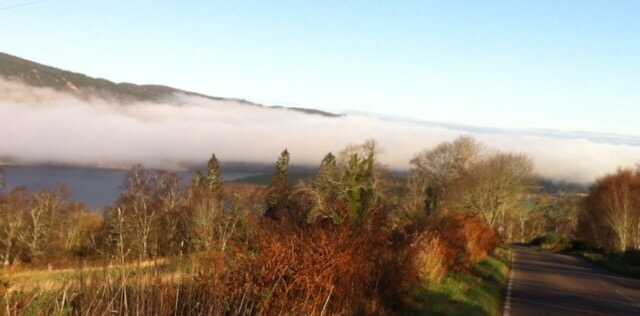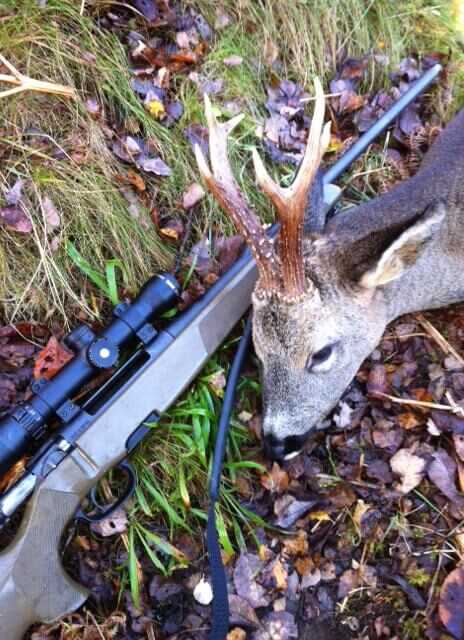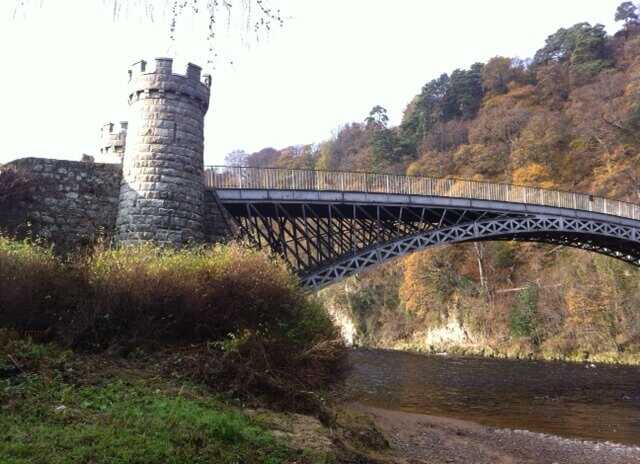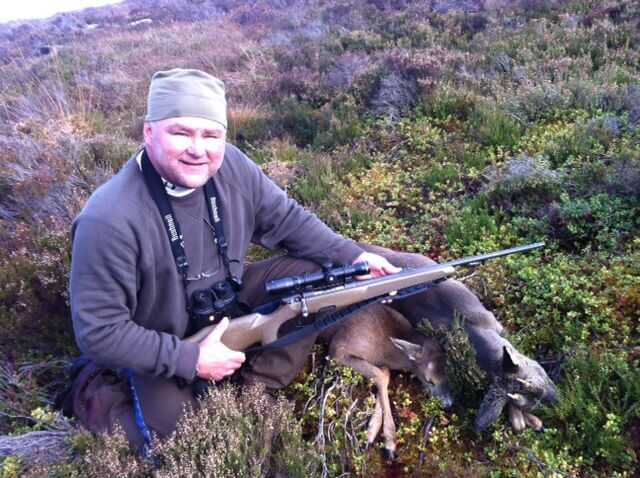When I hunt a new area I typically try only for a representative animal. I try to enjoy the atmosphere and intricacies of the hunt rather than strive for a trophy size animal. I find I have much more fun and create better memories doing so, rather than stressing over the quality of the animal itself. My hunt for Scottish Roe deer was undertaken using this same principle. It was unknown to me but we would be hunting the highlands surrounding Loch Ness of all places. This detail added considerably to the memory of the hunt. We stayed in a bed and breakfast right on the shoreline of the legendary loch.

The gamekeeper of the property was extremely knowledgeable and very keen on sorting out his hunter’s ability. He was a crusty old Englishman from Manchester that worked the properties of a wealthy man from central England.
He was a bit leery of the “Yank” that he had to haul around looking for stag and Roe deer. We drove up from the south of England in Dorset, to Manchester and picked up the gamekeeper, and continued our drive to Inverness and on to Loch Ness.

That first evening we hiked into our hunting area to glass the slopes, in hopes of spotting Red Stag, Roe, or Sika deer. We spotted a few Roe, but nothing else. As the evening light faded it became clear to me how legends and stories of werewolves, sea monsters, and other such creatures could come to be. There was an eerie stillness, a light fog, and shadows played tricks on the eyes. A bird flushed from cover could easily become something else running through the woods, or running at you. We would have a good hot pub meal and a single malt, and then to bed, as the morning would bring lots of walking. We started our morning walk in the predawn hours, we needed to get high so we could watch for game from above. The morning temps were close to freezing, but twenty minutes into our walk and I was shedding outer layers in an effort to keep from overheating.

My gamekeeper had confessed the night before to having asthma, ….thank you, Jesus! I’d hate to think what it would have been like if he didn’t stop every 10 minutes or so. Having guided hunters myself, I knew the importance of staying close in case game was spotted unexpectedly. So I decided to not let him get more than ten steps away from me at any time unless he told me to stay put.
We were an hour into our climb to the top, and the sun was peeking over the horizon when we stopped to glass a small meadow. There on a slope was a small white butt, it was a Roe deer. Spotting Roe deer is much like spotting pronghorn, the distinctive light-colored butt stands out in great contrast to the surrounding terrain. I quickly ranged it and verified it was a buck, I could shoot a doe or buck, but a buck was my first choice. Having binoculars and rangefinder all in one package was a real benefit. The Bushnell Fusion 10×42 bino/LRF has become a necessary part of my hunting kit. The range was 225 yards, downhill and across a small drainage. The ferns were thick, and he disappeared a couple of times. I eased up to a large rock protruding from the ground and sprawled over it, using my pack as a rest. It was a solid shooting position. My rifle was a Steyr Professional in 6.5×55, it shot a 140gr. Sierra Gameking of unknown velocity. The combination made for a great stalking rifle and with its 1.25-8x Bushnell scope, every part of the rig was perfectly matched to each other.

Once the buck came back into view and stopped moving, I settled the crosshairs high on his chest, as the rifle was sighted for 200 yards. At the shot, I saw dust fly from a rock that he was standing in front of, I had forgotten to allow for the increased downhill angle as he ambled about further downhill. I racked another round into the chamber, regained my composure, found him in the scope, and held on the bottom of his chest and fired. I saw him take the hit, turn, and run uphill. I racked another round into the chamber and was getting ready to fire again when the gamekeeper said wait, he’s going down. We both couldn’t understand why he ran uphill after being hit? They’re not supposed to do that. The gamekeeper had him spotted and knew how to get over to where he lay, it would take us almost an hour to make our way over to him. Once we got to him, I was very pleased, in the rush to take him I never really looked him over. He was exactly what I had hoped for; a respectable buck, taken in classic Scottish hilly terrain. We would continue to hunt the area for the rest of the day in hopes of spotting a stag or sika. Unfortunately, we would have no luck on looking for more deer.
Our plans were to move to different hunting grounds, further to the west along the whiskey trail.

Now that perked my interest up a bit! We would drop off the Roe buck to a friend of the gamekeepers that had cold storage, while we continued to hunt. We drove to the town of Aberlour on the river Spey, stayed in another B&B, and would hunt just south of town on the moors. The land was a mix of dark timber, heather, fern-covered moors, and small cultivated fields. It was all private land owned by the same gentleman who owned the previous hunting land, with a mix of smaller parcels owned by locals that we had permission from. On our first morning, we crossed a smaller parcel that was used to raise pheasant for the hunting industry. We came upon a pair of red fox that were hunting their own pheasant and needed to be removed. I was only too happy to comply with the request, as I had never taken a red fox. The morning was cold and frosty so there was a light fog hanging in the air as the warmth of the dawn warmed the air. This allowed us to close the distance on the fox, as their attention was on working the field. Using 2 shooting sticks from the standing position really isn’t as stable as I’d thought, and I again muffed the first shot but was able to recover and a quick second shot put the fox down as he ran for cover. This, of course, endeared me to my gamekeeper, and he started referring to me as “2 shot Trapr”. It was all in good fun, and I would go on to tell him that I always fired a “warning shot”. The owner of the parcel was happy to have the game thief gone, and I had accomplished another first. We would hunt the rest of the day and have no luck, but sighted several more Roe deer in the distance, so hopes were high for success the following day.

The last day was a bit warmer but wetter, and still very cool in the early or late hours. I learned quickly that walking in the moors was like walking uphill all the time, regardless if you were going up or down. Having to lift your foot up and over the soft ground and then place it on solid ground was very tiring, and worked my quadriceps tremendously. We would sneak about in the dark timber and pop out into the moors looking for possible game that might be spooked by our movements. The only time we were able to spot anything was when we caught it out on the moor. Late in the afternoon, I was able to spot two white butts feeding in shallow undulating terrain, they were a long way off. We ducked into the dark timber to close the distance quickly, when we came out we were five to six hundred yards away. The gamekeeper stayed with me until we were about four hundred yards away and then let me close the final distance on my own. When I stood I could see them but when I knelt or sat, they would disappear behind a small rise, I needed to either get closer or find a taller stable rest. I closed to about 250 yards and tried using my pack as a rest, still not tall enough. Off to my right, about 150 yards away was a small cluster of pine trees, it would put me within 200 yards of the Roe deer. I had lost sight of my gamekeeper but knew his general location was at about 9 o’clock to where the deer was, and I was at 6 o’clock to them. I was able to make the pine trees and use a branch to brace for the shot. I located the deer 185 yards away, picked out the largest, and held low on its chest. At the shot, deer exploded from cover, there were more deer there than I had noticed and the terrain had hidden them from view. I was able to locate the one I’d shot at and was getting ready to fire again (as it was still on its feet) when I noticed steam escaping from its chest at the exit wound. It was hit hard and not going anywhere. I swung onto a deer that had run towards me and stopped, I fired and dropped it. Another deer was trotting to my left as I reloaded another round into the chamber, I tracked it through the scope but stopped as it started going further toward where I’d left the gamekeeper. Two shots fired, two deer down, of course, the gamekeeper didn’t know there were two deer down. Only that two shots had been fired, so he was a bit surprised when I walked off and grabbed a second deer. We would have to drag the deer down off the moor and to the car, about 2 miles away. On the way, we bumped into two of the local property owners and briefly spoke about hunting and how good a hot meal and a whiskey would taste after a wet day on the moors. They had claimed to not have any luck themselves on deer, so rather than haul the meat to town and have it processed for our drive back to the south of England, I offered them the animals as a tribute for allowing us access to their properties. They gracefully accepted and I ended my hunt with an invitation to come back for pheasant or deer anytime.

The memories from that hunt will stay with me forever. The wish to return still lingers with me, and someday soon “2 shot Trapr” will return for a chance at stag, wild boar, and pheasant. Good times, good people, good country, and simple pleasures….those are what my memories are made of.



As an aficionado of that incomparable libation, I must offer a spelling correction. The proper spelling for Scottish malt “uisge beatha” is “whisky”, without an “E”. Slàinte Mhath to you!